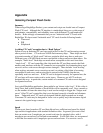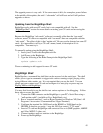42
Appendix
Selecting Compact Flash Cards
Summary
When using a BrightSign Product, your content and scripts are loaded onto a Compact
Flash (CF) card. Although the CF interface is standardized, there are a wide range of
performance, compatibility, and reliability issues with different CF card brands and
models. Roku strongly recommends that you use “industrial rated” CF cards with
BrightSign. We have tested “industrial rated” CF cards from the following brands:
• Transcend
• PQI
• Simpletech
Avoiding CF Card Corruption due to “Read Fatigue”
Failure to use an Industrial CF card can result in files on the CF card becoming corrupt
after a period of time. CF cards use NAND flash memory chips. These chips are rated
at a certain number of “block reads” before a particular block may have a read error.
Different types of NAND flash are more susceptible to these read errors than others. For
example, “multi-level” flash chips are much more susceptible to this read issue than
“single level”. CF card controllers (the chip inside the CF card that controls the flash
memory and interfaces with the CF connector) are responsible for eliminating these read
errors as well as write errors through various strategies. These include “wear leveling”
when writing, automatic error correction on read, re-writing a block that is becoming
susceptible to read errors, and moving blocks around in the NAND chip that are
repeatedly read over and over. If the CF card is designed correctly for repeated use, the
CF card user will never notice read or write issues. However, not all CF cards are
designed this way: in particular, certain models of consumer CF cards are not designed
for repeated read use.
In a typical BrightSign application, there might be an “attract video loop”. If this video is
fairly short, then a small number of flash blocks will be repeatedly read. Over a month or
so, the number of times the attract loop is read can be enough to trigger the “fatigue read
errors” if the CF card’s controller chip is not designed correctly to handle and eliminate
them. “Industrial rated” CF cards are designed with this high-repeated use in mind.
Consumer CF cards may be designed in lower cost or quality ways that assume a digital
camera is the typical usage scenario.
Speed
We have not found a modern CF card that did not have sufficient read speed for digital
sign and kiosk applications with standard definition video. In general you want a card
that can sustain over 3 megabytes per second read rates for standard video, with 4
megabytes per second easy to find and recommended. For Hi-Def video, we recommend
a card that can sustain over 6 megabytes per second read rates. You can test a card’s


















